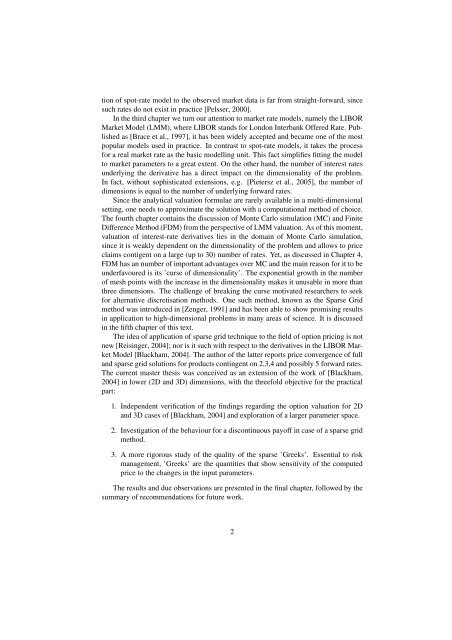sparse grid method in the libor market model. option valuation and the
sparse grid method in the libor market model. option valuation and the
sparse grid method in the libor market model. option valuation and the
Create successful ePaper yourself
Turn your PDF publications into a flip-book with our unique Google optimized e-Paper software.
tion of spot-rate <strong>model</strong> to <strong>the</strong> observed <strong>market</strong> data is far from straight-forward, s<strong>in</strong>ce<br />
such rates do not exist <strong>in</strong> practice [Pelsser, 2000].<br />
In <strong>the</strong> third chapter we turn our attention to <strong>market</strong> rate <strong>model</strong>s, namely <strong>the</strong> LIBOR<br />
Market Model (LMM), where LIBOR st<strong>and</strong>s for London Interbank Offered Rate. Published<br />
as [Brace et al., 1997], it has been widely accepted <strong>and</strong> became one of <strong>the</strong> most<br />
popular <strong>model</strong>s used <strong>in</strong> practice. In contrast to spot-rate <strong>model</strong>s, it takes <strong>the</strong> process<br />
for a real <strong>market</strong> rate as <strong>the</strong> basic <strong>model</strong>l<strong>in</strong>g unit. This fact simplifies fitt<strong>in</strong>g <strong>the</strong> <strong>model</strong><br />
to <strong>market</strong> parameters to a great extent. On <strong>the</strong> o<strong>the</strong>r h<strong>and</strong>, <strong>the</strong> number of <strong>in</strong>terest rates<br />
underly<strong>in</strong>g <strong>the</strong> derivative has a direct impact on <strong>the</strong> dimensionality of <strong>the</strong> problem.<br />
In fact, without sophisticated extensions, e.g. [Pietersz et al., 2005], <strong>the</strong> number of<br />
dimensions is equal to <strong>the</strong> number of underly<strong>in</strong>g forward rates.<br />
S<strong>in</strong>ce <strong>the</strong> analytical <strong>valuation</strong> formulae are rarely available <strong>in</strong> a multi-dimensional<br />
sett<strong>in</strong>g, one needs to approximate <strong>the</strong> solution with a computational <strong>method</strong> of choice.<br />
The fourth chapter conta<strong>in</strong>s <strong>the</strong> discussion of Monte Carlo simulation (MC) <strong>and</strong> F<strong>in</strong>ite<br />
Difference Method (FDM) from <strong>the</strong> perspective of LMM <strong>valuation</strong>. As of this moment,<br />
<strong>valuation</strong> of <strong>in</strong>terest-rate derivatives lies <strong>in</strong> <strong>the</strong> doma<strong>in</strong> of Monte Carlo simulation,<br />
s<strong>in</strong>ce it is weakly dependent on <strong>the</strong> dimensionality of <strong>the</strong> problem <strong>and</strong> allows to price<br />
claims contigent on a large (up to 30) number of rates. Yet, as discussed <strong>in</strong> Chapter 4,<br />
FDM has an number of important advantages over MC <strong>and</strong> <strong>the</strong> ma<strong>in</strong> reason for it to be<br />
underfavoured is its ’curse of dimensionality’. The exponential growth <strong>in</strong> <strong>the</strong> number<br />
of mesh po<strong>in</strong>ts with <strong>the</strong> <strong>in</strong>crease <strong>in</strong> <strong>the</strong> dimensionality makes it unusable <strong>in</strong> more than<br />
three dimensions. The challenge of break<strong>in</strong>g <strong>the</strong> curse motivated researchers to seek<br />
for alternative discretisation <strong>method</strong>s. One such <strong>method</strong>, known as <strong>the</strong> Sparse Grid<br />
<strong>method</strong> was <strong>in</strong>troduced <strong>in</strong> [Zenger, 1991] <strong>and</strong> has been able to show promis<strong>in</strong>g results<br />
<strong>in</strong> application to high-dimensional problems <strong>in</strong> many areas of science. It is discussed<br />
<strong>in</strong> <strong>the</strong> fifth chapter of this text.<br />
The idea of application of <strong>sparse</strong> <strong>grid</strong> technique to <strong>the</strong> field of <strong>option</strong> pric<strong>in</strong>g is not<br />
new [Reis<strong>in</strong>ger, 2004]; nor is it such with respect to <strong>the</strong> derivatives <strong>in</strong> <strong>the</strong> LIBOR Market<br />
Model [Blackham, 2004]. The author of <strong>the</strong> latter reports price convergence of full<br />
<strong>and</strong> <strong>sparse</strong> <strong>grid</strong> solutions for products cont<strong>in</strong>gent on 2,3,4 <strong>and</strong> possibly 5 forward rates.<br />
The current master <strong>the</strong>sis was conceived as an extension of <strong>the</strong> work of [Blackham,<br />
2004] <strong>in</strong> lower (2D <strong>and</strong> 3D) dimensions, with <strong>the</strong> threefold objective for <strong>the</strong> practical<br />
part:<br />
1. Independent verification of <strong>the</strong> f<strong>in</strong>d<strong>in</strong>gs regard<strong>in</strong>g <strong>the</strong> <strong>option</strong> <strong>valuation</strong> for 2D<br />
<strong>and</strong> 3D cases of [Blackham, 2004] <strong>and</strong> exploration of a larger parameter space.<br />
2. Investigation of <strong>the</strong> behaviour for a discont<strong>in</strong>uous payoff <strong>in</strong> case of a <strong>sparse</strong> <strong>grid</strong><br />
<strong>method</strong>.<br />
3. A more rigorous study of <strong>the</strong> quality of <strong>the</strong> <strong>sparse</strong> ’Greeks’. Essential to risk<br />
management, ’Greeks’ are <strong>the</strong> quantities that show sensitivity of <strong>the</strong> computed<br />
price to <strong>the</strong> changes <strong>in</strong> <strong>the</strong> <strong>in</strong>put parameters.<br />
The results <strong>and</strong> due observations are presented <strong>in</strong> <strong>the</strong> f<strong>in</strong>al chapter, followed by <strong>the</strong><br />
summary of recommendations for future work.<br />
2
















